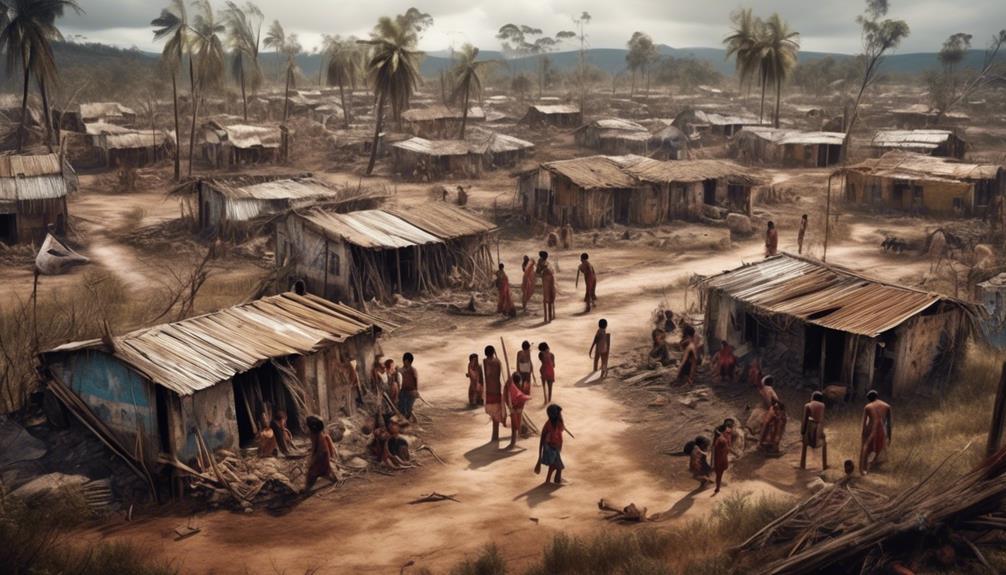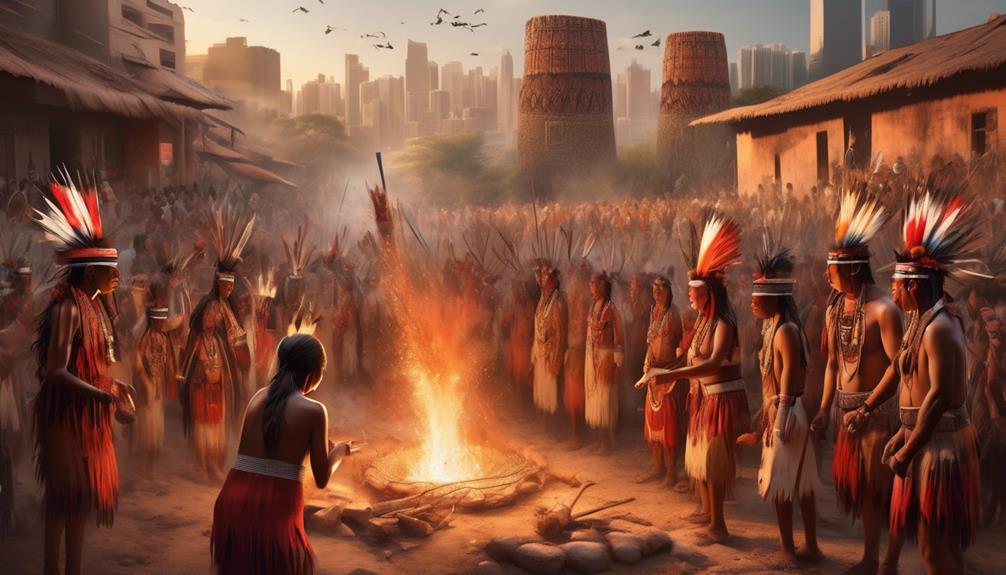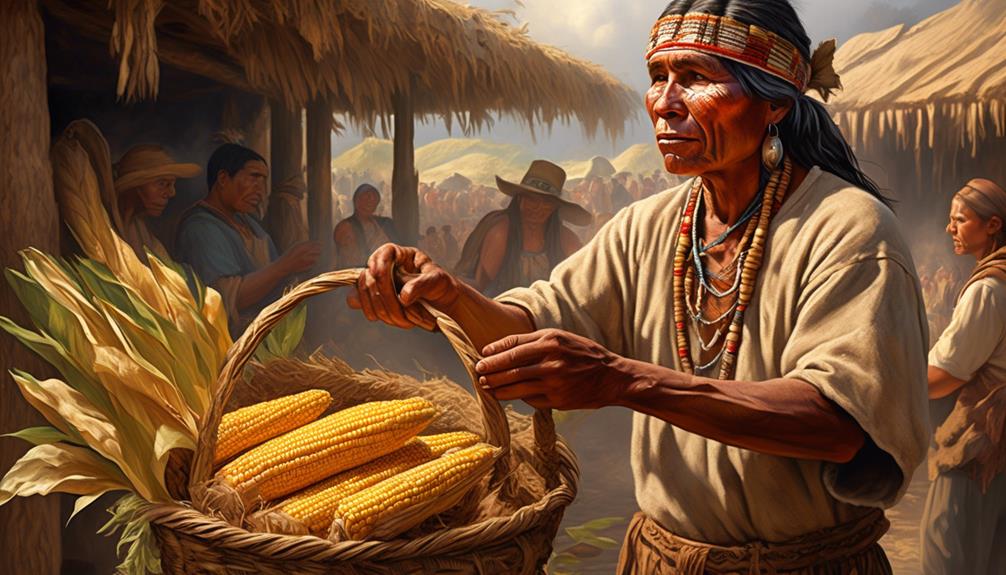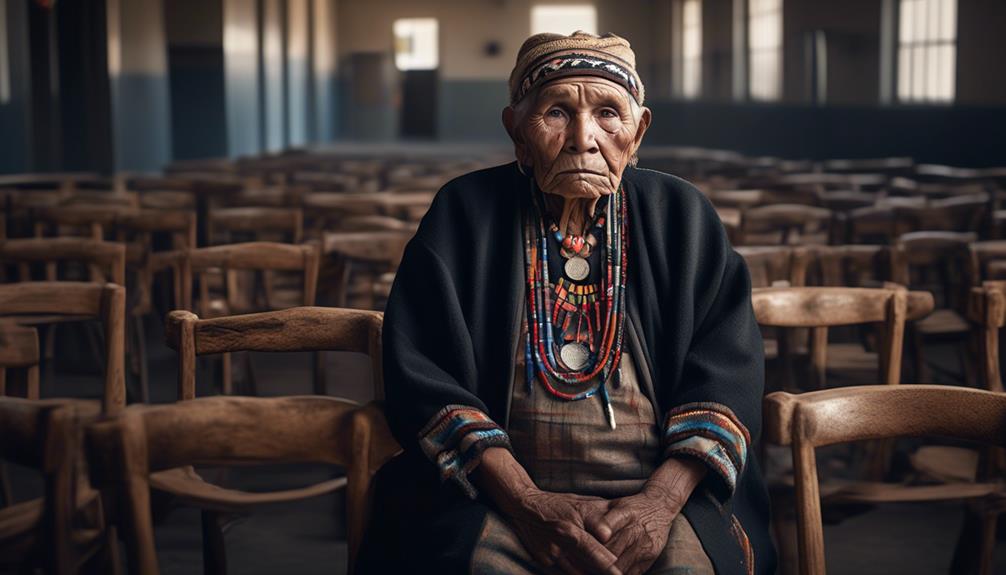We often see the expansion of settlements as a natural part of societal progress, but it is important to recognize the impact on indigenous communities as well.
The effects of increasing settlement on these communities were profound and far-reaching. Displacement, loss of traditional lands, and the erosion of indigenous cultures were just a few of the challenges faced by these groups.
However, delving into the intricacies of how these impacts shaped indigenous communities provides a deeper understanding of the lasting effects on their societies.
Key Takeaways
- Indigenous communities face displacement and loss of traditional lands due to increasing settlement and development, severing their connection to the land and impacting cultural identity.
- Introduction of foreign diseases by settlers had devastating health consequences for indigenous groups, leading to high mortality rates and disruptions to traditional way of life.
- Violent conflicts and warfare significantly shaped the experiences of indigenous communities, resulting in intergenerational trauma, mental health issues, and cultural resilience in preserving traditions.
- Cultural assimilation and the dominance of global languages have led to the erosion of indigenous cultures, including the loss of traditional practices, beliefs, languages, and distinct identities.
Displacement and Loss of Traditional Lands
Indigenous communities face the devastating reality of displacement and the consequent loss of their traditional lands as settlement and development encroach upon their territories. This displacement not only strips them of their homes but also severs their deep-rooted connection to the land, which is integral to their cultural identity. The forced removal from their ancestral lands disrupts age-old traditions and societal structures, leading to profound psychological and emotional impacts on the community as a whole.
Moreover, the loss of access to natural resources and sacred sites due to displacement hinders their ability to practice traditional customs and rituals, further exacerbating the erosion of their cultural heritage.
As indigenous peoples are uprooted from their lands, they often face pressures to assimilate into the dominant culture of the settling population. This cultural assimilation, whether overt or subtle, poses a significant threat to the preservation of indigenous languages, knowledge, and customs. It undermines the transmission of traditional practices from one generation to the next, further endangering the rich tapestry of indigenous cultures.
The loss of traditional lands and the subsequent assimilation challenges the very existence of indigenous communities, highlighting the urgent need for safeguarding their rights and heritage in the face of increasing settlement.
Impact of New Diseases

With the arrival of new diseases, the health and well-being of indigenous communities face unprecedented challenges, necessitating a comprehensive understanding and proactive response to mitigate the impact.
The introduction of foreign pathogens has had devastating health consequences for indigenous groups. Diseases such as smallpox, measles, and influenza, brought by settlers, ravaged populations with no prior exposure, leading to staggering mortality rates. The lack of immunity and access to medical care made these communities particularly vulnerable, resulting in profound disruptions to their social fabric and traditional way of life.
The impact of these new diseases goes beyond the immediate loss of lives, as it also affects the cultural resilience of indigenous groups. The erosion of traditional knowledge and practices due to widespread illness and death further undermines the preservation of their heritage.
However, amidst these challenges, indigenous communities have shown remarkable resilience, adapting to new health realities and preserving their cultural identity. Understanding the historical and ongoing impact of new diseases is crucial in recognizing the strength and perseverance of indigenous communities in the face of adversity.
Violent Conflicts and Warfare
The devastating impact of new diseases on indigenous communities has, unfortunately, not been the only challenge they've faced; violent conflicts and warfare have also significantly shaped their experiences and continue to impact their lives today. This historical trauma has left a lasting impact, leading to intergenerational trauma that affects indigenous communities to this day.
The scars of violent conflicts and warfare run deep, with the repercussions echoing across generations, impacting mental health, social structures, and cultural practices.
- Intergenerational Trauma: The trauma and loss experienced by indigenous communities during violent conflicts have been passed down through generations, impacting mental and emotional well-being and contributing to ongoing social challenges.
- *Impact on Mental Health*: The enduring effects of violent conflicts and warfare have led to high rates of post-traumatic stress disorder, depression, and substance abuse within indigenous communities.
- *Cultural Resilience*: Despite the immense challenges, indigenous communities have demonstrated remarkable cultural resilience, striving to preserve their traditions and knowledge systems in the face of historical trauma. This resilience serves as a testament to the strength and perseverance of these communities in the wake of such adversity.
Erosion of Indigenous Cultures

Despite the ongoing resilience of indigenous communities, the erosion of their cultures highlights pressing challenges that demand our attention and understanding. Cultural assimilation, often forced upon indigenous groups through the imposition of dominant cultures, has led to the gradual loss of traditional practices, beliefs, and customs. The impact of cultural assimilation extends beyond the surface level, permeating deep into the fabric of indigenous societies, altering their way of life and eroding their distinct identities.
Language preservation is a crucial component of cultural heritage. Many indigenous languages, each a repository of unique knowledge and worldview, are at the risk of extinction due to the dominance of global languages. The loss of indigenous languages represents a severe blow to the preservation of traditional knowledge, storytelling, and intergenerational transmission of cultural practices.
Recognizing and addressing the erosion of indigenous cultures is imperative for the preservation of humanity's diverse heritage. It requires concerted efforts to empower indigenous communities to reclaim, revitalize, and transmit their cultural practices and languages. By acknowledging the value of indigenous cultures and supporting their preservation, we can contribute to a more inclusive and enriched global society.
Lasting Effects on Indigenous Communities
The erosion of indigenous cultures due to cultural assimilation has left lasting and profound effects on the indigenous communities, permeating various aspects of their social fabric and challenging their long-term resilience. The consequences of cultural assimilation and economic marginalization are deeply entrenched in the indigenous communities, shaping their current realities and future prospects.
- Social Disintegration: Cultural assimilation has disrupted traditional social structures, eroding intergenerational knowledge transmission and community cohesion. This has led to a loss of cultural identity and weakened social bonds, contributing to a sense of disconnection and alienation within indigenous communities.
- *Impact on Mental Health*: The erosion of cultural identity and social disintegration has resulted in elevated rates of mental health issues such as depression, anxiety, and substance abuse within indigenous populations. The loss of traditional support systems and cultural practices has exacerbated these challenges, creating significant barriers to overall well-being.
- Economic Struggles: Economic marginalization stemming from historical injustices and ongoing systemic barriers has perpetuated poverty and limited economic opportunities for indigenous communities. This has resulted in persistent socio-economic disparities, hindering the ability of indigenous peoples to achieve financial stability and prosperity.
The enduring effects of cultural assimilation and economic marginalization continue to shape the experiences and realities of indigenous communities, necessitating comprehensive and culturally sensitive approaches to address these longstanding challenges.
Frequently Asked Questions
How Did the Increasing Settlement Affect the Spiritual Beliefs and Practices of Indigenous Groups?
Increasing settlement profoundly impacted the spiritual beliefs and practices of indigenous groups. The forced relocation and loss of traditional lands disrupted sacred sites and ceremonies, challenging spiritual resilience. However, indigenous communities demonstrated cultural adaptation, integrating traditional beliefs with new practices to nourish their spirituality.
Despite the adversity, they persevered, showcasing remarkable spiritual resilience and adaptability in the face of increasing settlement.
What Efforts Were Made to Preserve the Languages of Indigenous Communities in the Face of Increasing Settlement?
Preserving indigenous languages in the face of increasing settlement was akin to tending delicate orchids amidst a storm. Despite the challenges, communities championed language preservation as a pillar of cultural resilience.
Efforts ranged from formal education programs to grassroots initiatives, showcasing the unwavering determination to safeguard linguistic heritage.
The preservation of languages not only upheld tradition but also bolstered the resilience of indigenous communities in the face of encroaching settlement.
How Did the Introduction of New Technologies and Industries Impact the Traditional Economies of Indigenous Groups?
The introduction of new technologies and industries had a profound impact on the traditional economies of indigenous groups. They faced challenges in adapting to the rapid changes, as their economic systems were deeply intertwined with the natural environment.
The technological advancements disrupted their traditional ways of life, requiring them to adapt and find new means of economic sustenance.
It's crucial to recognize the resilience and resourcefulness of indigenous communities in navigating these complex transformations.
What Role Did the Government Play in the Displacement and Loss of Traditional Lands for Indigenous Communities?
We must acknowledge the significant impact of government involvement in the displacement and loss of traditional lands for indigenous communities. The government's policies and actions have led to severe land loss and undermined indigenous rights.
The forced removal from ancestral lands has had a devastating effect on indigenous communities, causing irreparable harm. It's imperative to address the historical injustices and work towards meaningful restitution and empowerment for indigenous peoples.
How Did the Increasing Settlement Affect the Mental Health and Well-Being of Indigenous Individuals and Communities?
Increasing settlement deeply impacted indigenous mental health and community well-being. The disruption of traditional ways of life, loss of land, and forced assimilation all contributed to profound psychological distress. This led to high rates of depression, substance abuse, and suicide in indigenous communities.
Additionally, the breakdown of community structures and social support systems further exacerbated these challenges. Understanding these impacts is crucial for addressing historical traumas and supporting indigenous healing and resilience.
Conclusion
In conclusion, it's clear that increasing settlement had a devastating impact on indigenous groups. How could we not see the profound loss of traditional lands, the devastation wrought by new diseases, and the violent conflicts that tore apart communities?
The erosion of indigenous cultures and the lasting effects on their communities can't be ignored. It's essential to acknowledge and address the deep wounds caused by this history.
Mary is a passionate writer who brings creativity and a fresh perspective to our team. Her words have the power to captivate and inspire, making her an essential contributor to our content. Mary’s commitment to storytelling and dedication to promoting Indigenous culture ensures that her work touches the hearts of our readers. We’re fortunate to have her as part of our team.










